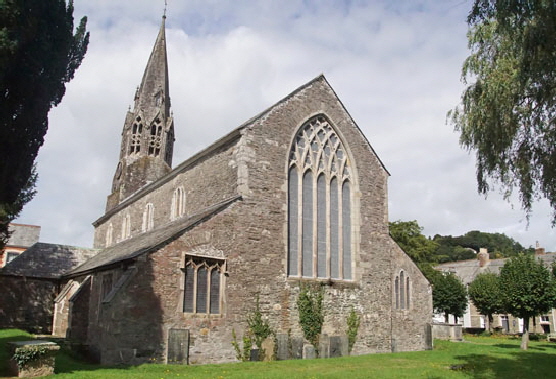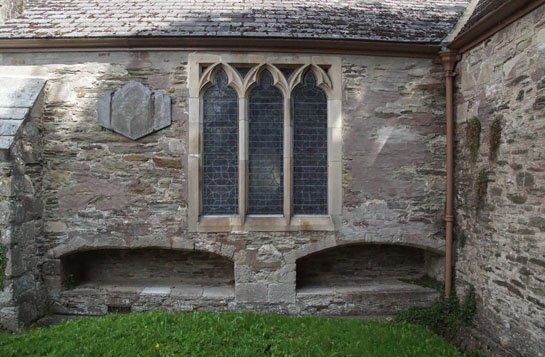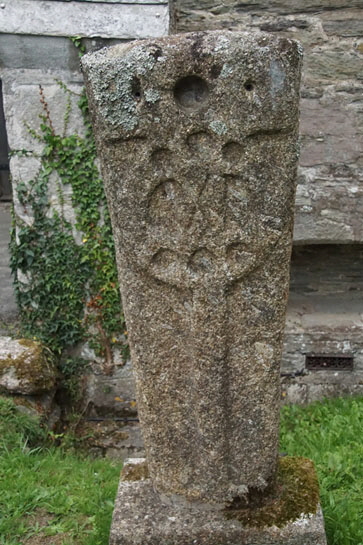|
Alphabetical List |
|
|
|
|
|
|
|
County List and Topics |
|
|
|
Please sign my Guestbook and leave feedback |
|
|
||||||||||||||||||||||||||||
|
The church dates from the twelfth century although at first sight it doesn’t look it. Close examination of the somewhat bizarre west tower, however, reveals early windows as far as the somewhat incongruous broach spire section that was added in the fourteenth century. For those of you who haven’t yet encountered broach spires it was an ingenious method of allowing the grafting of an octagonal spire onto a tower of square cross-section. see other examples at Ryhall and Ketton both in Rutland. They were all the rage in that part of the East Midlands. Other clues to the early origins of the church are in the minuscule aisles and the small triple lancet windows of the north aisle. The great height of the nave is startling especially in this part of England. If you didn’t know better you might suspect Anglo-Saxon origins but this church is, of course, nothing of the kind. The great Perpendicular style east window stretching almost to the roof gable and the large clerestory windows tell you that it was a case of a fourteenth century yen for grandiose proportions that is also evident in the spire. It is odd, I feel, that despite a near mania for it elsewhere especially in the fifteenth century the church made no efforts to extend the aisles to match this enlargement, leaving them looking somewhat overwhelmed. Pevsner reckons the great east window in an early-ish Perpendicular style “one of the most sumptuous in Cornwall” and it is a thrill to see an east window that hasn’t been “remodelled” by the pesky Victorians - although new glass was inserted. So to that barmy font. Pevsner puts it as early fourteenth century and rates it “outstanding” but really I can see no hard stylistic evidence for that dating. It is octagonal so we can probably rule our anything really early. That probably doesn’t matter much when all is said and done. As a composition it is simply a riot. It has a hunting scene (part of which sadly seems to have been defaced). It has a leering grotesque head (past commentators have designated it as “an ape”) surmounted by a monster. It has two lions - or leopards? - in profile, It has a hunting scene. Best of all and “worth the price of the admission for this alone” is a green bishop carving. Yes, that’s a mitred head of a bishop with leaves emanating from his mouth! Then, almost as a nod to the “you know, that Christianity thing” there is a crucifixion scene. It’s crazy. It is the sort of thing a Norman mason might have carved but this isn’t Norman. Pevsner reckons the crucifixion might have been put there later and he could be right because anything sacred on this font is downright incongruous! It was desecrated during the Civil War. The roundhead soldiers baptised a horse at the font after the Battle of Lostwithiel in 1644 and called it “Charles”! The naughty little rascals, eh? St Paul's Cathedral (the old one that was destroyed in the Great Fire, of course) and Yaxley in what was then Huntingdonshire suffered similar fates, by the way. At Lostwithiel the minor miracle is that they didn’t also use the east window for target practice. |
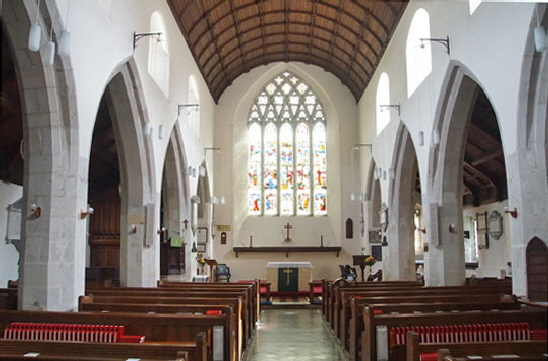 |
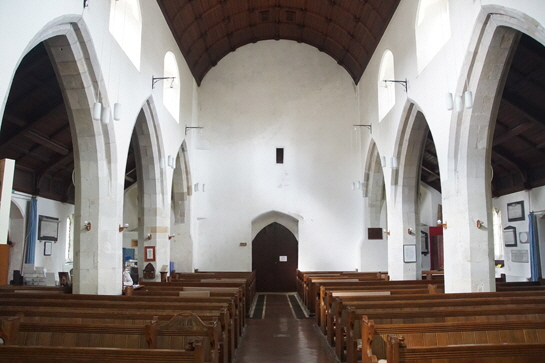 |
||
|
Left: Looking east towards the great window. It is a straight run through the church. There is no distinct space for the chancel: the roof just sweeps from west to east in one uninterrupted line. There are signs that the area delineated by the last two bays was at once separated by a rood screen. There is no sign of stair or loft. Note the arcades which are identical and which have a very elegant simplicity unusual for the region. The church Information Boards attribute this to influences from Brittany. Right: Looking towards the west. The west wall is breached only by an apology for a tower arch and a tiny window. |
 |
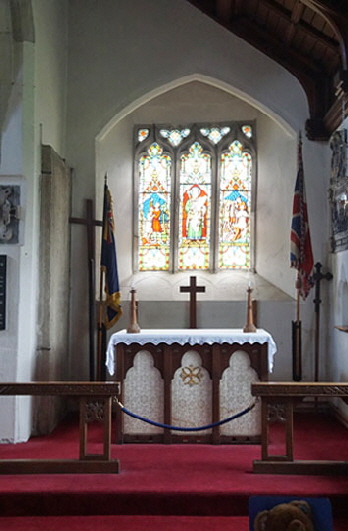 |
||||
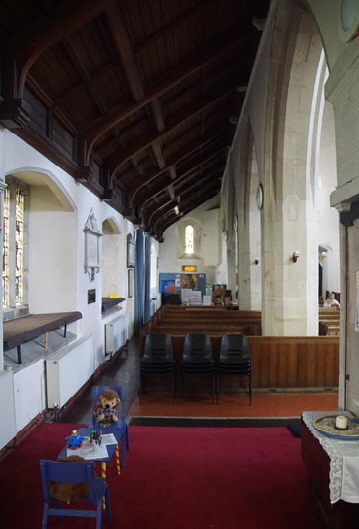 |
|||||
|
Left: The east window is very impressive, although the glass dates only from 1886. Centre: The south aisle chapel. Right: Looking down the south aisle to the west. Note the narrowness and the steeply-pitched roof. |
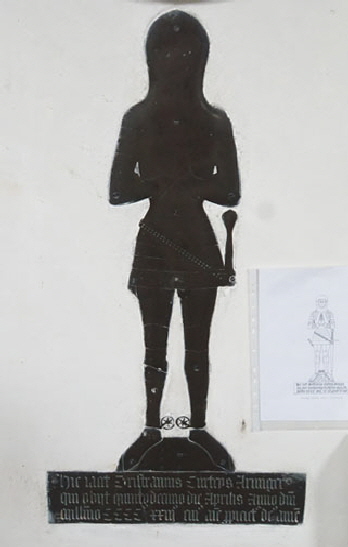 |
||||||||||||||||||
 |
 |
|||||||||||||||||
|
Left: The brass memorial to Trystan Curtys, MP for Lostwithiel 1419-21. Centre: The Poor Box was donated by the Mayor William Taprell in 1645. It is inscribed by the maker W.T.Maier. Right: The seventeenth century monument of Thomas Kendal |
||||||||||||||||||
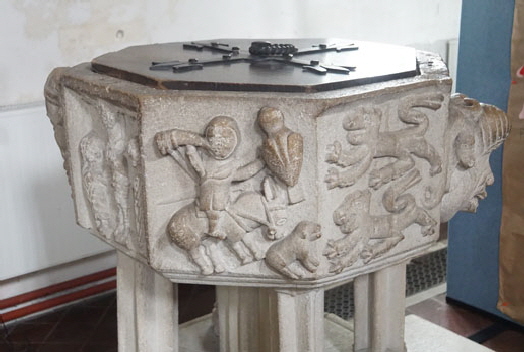 |
||||||||||||||||||
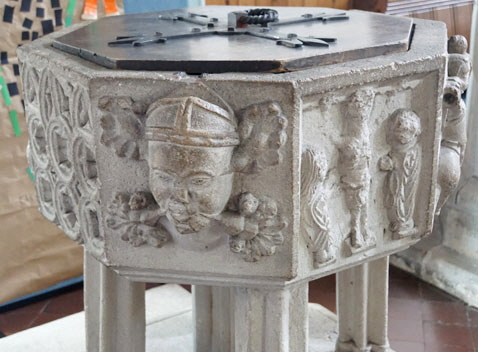 |
||||||||||||||||||
|
Left: So to the font and on this panel you can see the perplexing “green bishop”. To its right is the somewhat incongruous and defaced crucifixion scene. Right: A hunting scene and the strange pair of heraldic lions or leopards. To the right you can see the grotesque head that protrudes in the mots startling way. Really, the mason seems to have regarded this font as a black canvas upon which he could allow his imagination to run riot. |
||||||||||||||||||
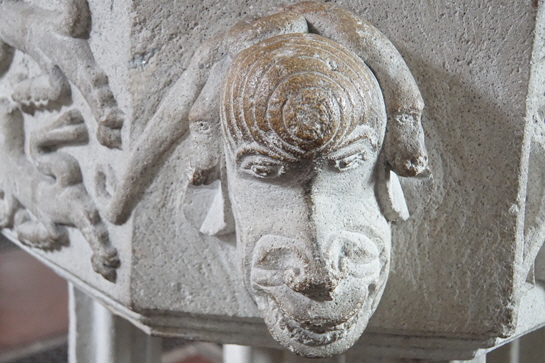 |
||||||||||||||||||
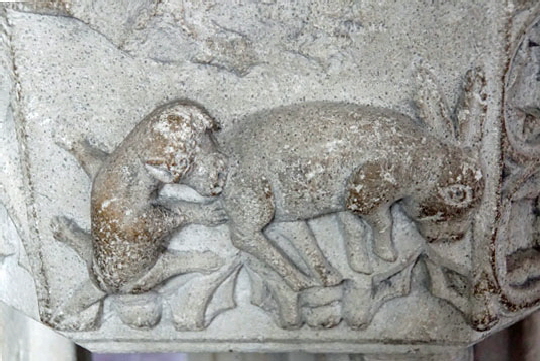 |
||||||||||||||||||
|
Left: The grotesque head. Snake-like creatures hand each side of the head. Right: A very peculiar scene. A dog, his legs improbably splayed, has his teeth into a rabbit or hare of improbable size and with most unrabbit-like legs. It could almost be a donkey though I’m sure it’s not. What was above it has been defaced. |
||||||||||||||||||
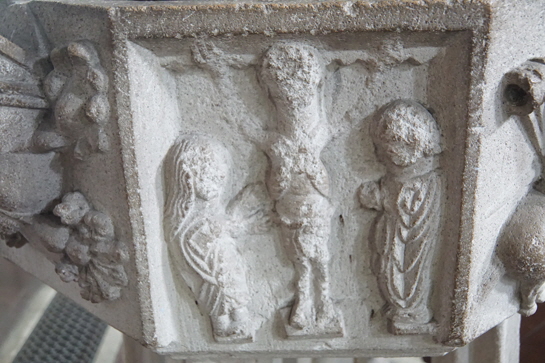 |
||||||||||||||||||
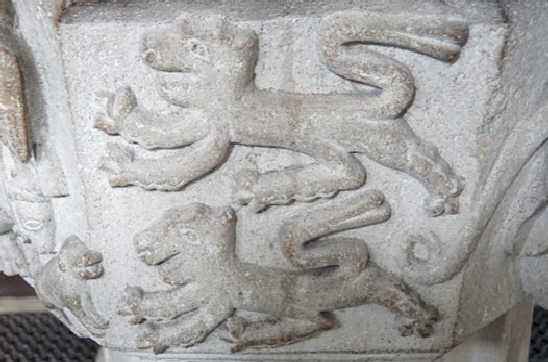 |
||||||||||||||||||
|
Left: The tails give little room for doubt that these big cats are meant to be heraldic. Right: The crucifixion scene is a bit peculiar. Christ seems to be handing from a bar, his feet on a block. He is flanked by Mary and St John in draped robes in rather meaningless poses. |
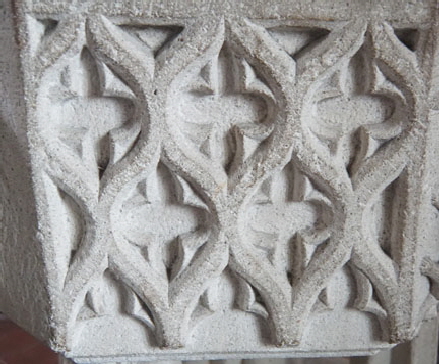 |
||||||||||||||
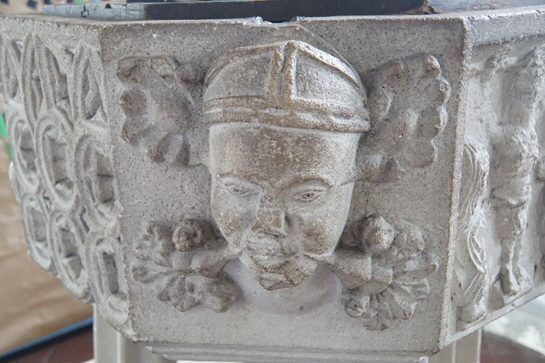 |
||||||||||||||
|
Left: The green bishop. What a curiosity this is. What can it mean? Let’s begin by acknowledging that the whole font is a piece of self-indulgence on the part of the mason. You could make a case that the hunting scenes and the big cats are some sort of tribute to the local lord. There are those who might read some sort of morality lesson into the head with the beasts - although it’s a tired and lazy “explanation”. But this bishop? Whole books are written about the green man. They mainly exist on a continuum with implausible intellectuality at one end and wild flights of pagan fantasy at the other! How, I wonder, would the authors explain a green bishop!? My own stab in the dark is satire. Bishops, mighty, worldly and wealthy were not universally popular. Some were also known to be less than sexually continent. Celibacy was a requirement of the priesthood by now but philandering was far from unknown. The most popular theory for the green man is as a fertility symbol. Is this image a poke at a bishop thought to have a less than blameless private life? Right: A decorative panel. This is actually a rather fine piece of carving. |
||||||||||||||
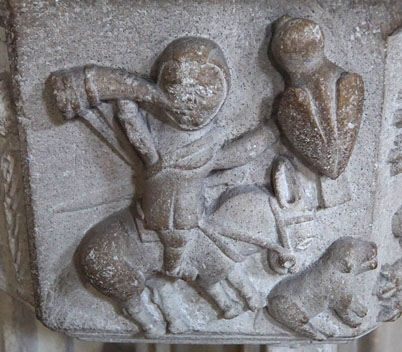 |
 |
|||||||||||||
|
Left: This is a vibrant hunting scene. Proportion has played second fiddle to symbolism. The hunter blows his horn while he carries an outsized falcon on his arm. He must have had big biceps! There is quite a lot of detail here. The horse has a harness and saddle. The horn has a cord. Right: Another decorative panel. |
||||||||||||||
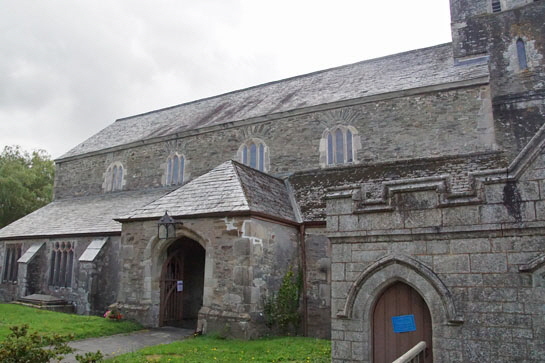 |
||||||||||||||
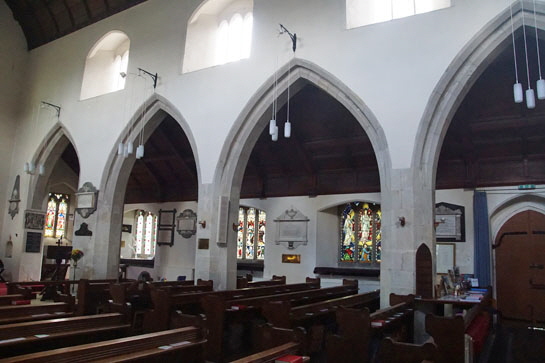 |
||||||||||||||
|
Left: The south aisle showing the large clerestory windows and perhaps emphasising the narrowness of the aisle. Right: The church from the north. It is very obvious that the windows have been remodelled at some point. |
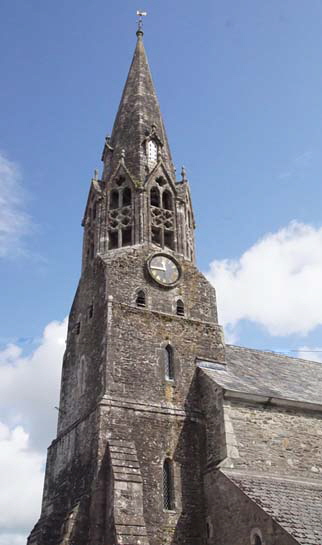 |
 |
||||
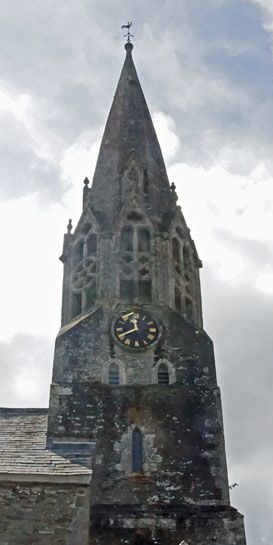 |
|||||
|
Left and Centre: The west tower. The spire must have been very avant-garde for its day. Whereas the Early English broach spires of the East Midlands are massive and their lines broken by small unglazed window spaces - so-called “lucarnes” - Lostwithiel’s spire has large and delicately crafted openings that make a continuous octagonal design. Above it is a a tier of lucarnes. It is very handsome indeed. Note, however, the small lancet-like windows on the lower stage that show us how early the tower itself is. The size of the buttresses show us that the masons had their own misgivings about the stability of the heightened structure. The spire indeed was taller but in 1757 a lightning strike brought it crashing to the ground. A contemporary account is quite instructive. The writer put the lantern stage as being nine feet high atop a tower of forty-three feet. The spire itself, according to this account, was another fifty-two feet. That is, the spire was as tall as the tower and lantern stages combined! Right: An oddity is the north west lantern opening. Whereas the others have a central tracery pattern of four quatrefoils this one is circular like a catherine wheel - which of course is possibly what it is meant to be. |
|
|
||||||||||||||||||||
|
|
